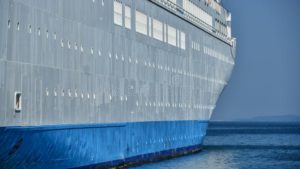A Brief Blast of The Sublime
Beauty sneaks up on us all the time. With the right mix of mood and happenstance, it can be almost anything —a face on the street, a song heard on the radio, the light before a storm. But when beauty is pumped up to the level of spectacle —what people used to call the sublime — it’s less spontaneous. It demands a date. You must climb a mountain or at least pull into the scenic viewing area.
Then again, sometimes something awe-inspiring will muscle its way into your personal space.
We were on a ferry departing from West 38th Street. It was a Saturday, at twilight. Most of us were coming back from shopping, or matinees, or some other Manhattan enticement. We were divided into upper deck and lower deck contingents: children and romantics in the upper, practical types and hardened commuters in the lower.
The ferry was just picking up speed, throwing back gusts of salt air and diesel fumes. As Manhattan’s bristly shore receded, the sky opened to the horizons, bathing everything in a violet light. Upriver, the George Washington Bridge twinkled like a set of diamonds on a jeweler’s pad. The romantics onboard wondered why they hadn’t chosen a life at sea.
Then a horn blast. A tremendous bass note. It was loud enough to have been Gabriel’s Horn, if Gabriel had had a tuba. Two more followed it. A three-note warning: “I-am-here.” All heads turned to starboard. A gigantic ship was backing out of its berth.

Our skipper slowed the engines. We could have scooted by, like a car zipping around a slow-turning truck, but we didn’t. Here, little things waited for big things.
Nobody minded. The cruise ship came out surprisingly quickly for something so big. It didn’t churn the water with its propellers. It didn’t rock, or even make any noticeable waves. It just glided out, silent except for the stentorian horn blasts. It was white, all white: the hull, the smokestacks, the wedding-cake pile of decks.
In this strange purple light, it seemed luminous. And a little bit unreal. Ocean liner buffs cite the length of the biggest ones, or their gross tonnage. Rarely do they mention height. But when you’re in the water with one, bobbing around at sea level, you have a different perspective. This one looked hundreds of feet high. If I had to guess how many portholes, I would have said a thousand. It looked as big as a Manhattan high-rise, and yet it was moving.
The fact that it moved made it scary. Here was this gigantic thing, this huge machine-propelled object that floated on the water and contained ballrooms, swimming pools, elevators, and tennis courts. Even in the 21st century, it seemed a wonder of the world.
As it straightened out and slid past us, tiny figures waved from the railings. It was impossible not to wave back. There were more horn blasts. The huge ship was pointed toward the Verrazano Bridge, bound for … where? I had no idea. The name of the ship had been lost in the larger spectacle. I didn’t know whether it was a Norwegian, an Italian, or a British liner, no idea whether it was headed to a Caribbean island, up the coast to Canada, or straight out to sea – to make, as they used to call it, a crossing. Did it matter?
There’s a scene like this in Fellini’s “Amarcord.” It comes late in the film, when the townspeople take a flotilla of little boats out in the harbor to hail the arrival of a great new Italian liner. They wait far into the night, most of them falling asleep in their bobbing boats. Awakened by the booming horn, they open their eyes to a dazzling vision emerging from the fog: a gargantuan, elegant vessel, its portholes aglow. They wave with all their might, starry-eyed, as if seeing this ship was the culmination of a lifelong dream, as if it were bestowing all its majesty and glamour on them.
Reviewers tend to note that the ship in the film looks obviously fake. Fellini, they say, reveled in the artifice of movies. I watched it again, however, and I have to say that it looks about as unreal as the real thing does.
One thing in the scene did depart from my own experience. The people looked too innocently happy in their reaction. Memory might sort it out that way, yet in truth, sights like this make us tremble a bit, if only inwardly. They’re not just beautiful; they’re immensely powerful. Or, as people used to say, sublime.
A World By Design column
2003

